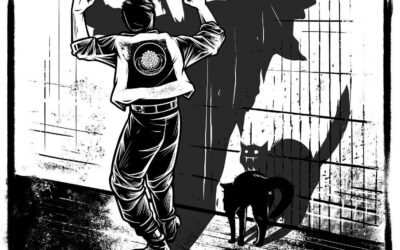Who is Eugen Bleuler?

1.1. The Significance of Eugen Bleuler’s Contributions to Psychiatry
Eugen Bleuler, the renowned Swiss psychiatrist, made groundbreaking contributions to the understanding and treatment of schizophrenia, a severe mental disorder that affects millions of people worldwide. His work revolutionized the conceptualization of the illness, moving away from the prevailing notion of “dementia praecox” as a progressive deterioration of mental functions, and towards a more nuanced and holistic understanding of the complex psychological processes underlying the disorder. Bleuler’s insights laid the foundation for modern approaches to the diagnosis, treatment, and research of schizophrenia, and his legacy continues to shape the field of psychiatry to this day.
In this comprehensive essay, we will explore the life and work of Eugen Bleuler, tracing the development of his ideas and their impact on the understanding of schizophrenia. We will examine his pioneering concept of “schizophrenia” as a splitting of mental functions, his emphasis on the psychological and subjective aspects of the illness, and his contributions to the development of psychotherapeutic approaches to treatment. By engaging with Bleuler’s thought, we aim to shed light on the enduring significance of his work for the field of psychiatry and the lives of those affected by schizophrenia.
-
Bleuler’s Early Life and Education
2.1. Family Background and Childhood
Eugen Bleuler was born on April 30, 1857, in Zollikon, a small town near Zurich, Switzerland. He was the son of Johann Rudolf Bleuler, a farmer and local politician, and Pauline Bleuler-Bleuler, who came from a prominent family of physicians and scholars. Growing up in a rural environment, Bleuler developed a deep appreciation for nature and a keen interest in the workings of the human mind.
2.2. Medical Education and Early Career
Bleuler pursued his medical education at the University of Zurich, where he studied under the renowned psychiatrist Auguste Forel. He graduated in 1881 and began his career as an assistant physician at the Waldau Psychiatric Clinic in Bern, Switzerland. During this time, Bleuler became increasingly interested in the psychological aspects of mental illness and the potential for psychotherapeutic interventions.
In 1886, Bleuler returned to Zurich to work at the Burghölzli Psychiatric Hospital, where he would spend the majority of his professional life. Under the mentorship of Auguste Forel, who was the director of the hospital, Bleuler began to develop his own approach to the understanding and treatment of mental disorders, with a particular focus on schizophrenia.
-
Bleuler’s Conceptualization of Schizophrenia
3.1. The Introduction of the Term “Schizophrenia”
One of Bleuler’s most significant contributions to psychiatry was his introduction of the term “schizophrenia” in 1908, replacing the earlier concept of “dementia praecox” proposed by Emil Kraepelin. Bleuler argued that the term “dementia praecox” was misleading, as it implied a progressive deterioration of mental functions, which he believed was not the core feature of the disorder.
Instead, Bleuler proposed that schizophrenia was characterized by a fundamental splitting or fragmentation of psychological functions, leading to a disruption in the integration of thoughts, emotions, and behaviors. He emphasized the diversity of symptoms and the potential for recovery, challenging the prevailing view of the illness as a uniformly progressive and deteriorating condition.
3.2. The Four A’s: Fundamental Symptoms of Schizophrenia
Bleuler identified four primary symptoms, which he considered to be fundamental to the diagnosis of schizophrenia. These symptoms, known as the “four A’s,” included:
Ambivalence:
The coexistence of contradictory thoughts, feelings, or attitudes towards the same object or situation.
Affect inappropriateness:
The discordance between the patient’s emotional expression and the context or content of their thoughts and experiences.
Autism:
The withdrawal from reality and preoccupation with internal experiences, leading to a loss of contact with the external world.
Association disturbances:
The disruption in the logical and coherent flow of thoughts, manifested in disorganized speech and behavior.
Bleuler considered these symptoms to be more fundamental to the nature of schizophrenia than the more florid and dramatic symptoms, such as hallucinations and delusions, which he viewed as secondary manifestations of the underlying psychological disturbances.
3.3. The Importance of Psychological and Subjective Factors
Bleuler’s approach to schizophrenia emphasized the importance of psychological and subjective factors in the understanding and treatment of the disorder. He believed that the symptoms of schizophrenia were not merely the result of biological or neurological abnormalities, but were deeply rooted in the patient’s life experiences, personality, and interpersonal relationships.
Bleuler argued that the psychological fragmentation observed in schizophrenia was a result of the patient’s attempts to cope with overwhelming emotional conflicts and stressors, often stemming from early childhood experiences or traumatic events. He emphasized the role of psychodynamic processes, such as repression, projection, and symbolization, in shaping the manifestations of the disorder.
This psychological perspective on schizophrenia represented a significant departure from the prevailing biomedical models of the time, which focused primarily on the identification of neurological lesions or hereditary factors as the causes of mental illness. Bleuler’s work laid the foundation for the development of psychotherapeutic approaches to the treatment of schizophrenia, which aimed to address the underlying psychological conflicts and promote the reintegration of the fragmented self.
-
Bleuler’s Contributions to the Treatment of Schizophrenia
-
4.1. The Burghölzli Approach: Humane and Individualized Care
As the director of the Burghölzli Psychiatric Hospital, Bleuler implemented a compassionate and individualized approach to the care of patients with schizophrenia and other mental disorders. He believed in the importance of creating a therapeutic environment that promoted the dignity, autonomy, and well-being of each patient.
Bleuler abolished the use of physical restraints and punitive measures, which were common practices in psychiatric institutions of the time. Instead, he emphasized the importance of building trust and rapport between patients and staff, and providing opportunities for meaningful engagement in work, leisure, and social activities.
Bleuler also recognized the heterogeneity of schizophrenia and the need for individualized treatment plans that took into account each patient’s unique needs, strengths, and circumstances. He encouraged the involvement of families and the wider community in the care and support of patients, and promoted the integration of psychotherapeutic interventions with pharmacological and other medical treatments.
4.2. The Development of Psychotherapeutic Approaches
Bleuler’s psychological understanding of schizophrenia paved the way for the development of psychotherapeutic approaches to the treatment of the disorder. He believed that psychotherapy could play a crucial role in helping patients to resolve underlying emotional conflicts, rebuild a coherent sense of self, and improve their overall functioning and quality of life.
Bleuler himself practiced a form of psychotherapy that combined elements of psychoanalysis, suggestion, and supportive counseling. He emphasized the importance of establishing a trusting and empathetic therapeutic relationship, and helping patients to gain insight into their experiences and develop adaptive coping strategies.
Bleuler’s work influenced the development of various psychotherapeutic approaches to schizophrenia, including Carl Jung’s analytical psychology, which emphasized the exploration of symbolic and archetypal material in the treatment of psychotic disorders. Other psychodynamic approaches, such as Frieda Fromm-Reichmann’s intensive psychotherapy and Harry Stack Sullivan’s interpersonal psychoanalysis, also drew on Bleuler’s insights into the psychological and relational aspects of schizophrenia.
While the effectiveness of psychotherapy for schizophrenia remains a topic of ongoing research and debate, Bleuler’s contributions laid the groundwork for the integration of psychological interventions into the comprehensive treatment of the disorder, alongside pharmacological and other medical approaches.
-
Bleuler’s Legacy and Impact
5.1. Influence on the Diagnostic Classification of Schizophrenia
Bleuler’s conceptualization of schizophrenia as a disorder characterized by a fundamental splitting of psychological functions had a profound impact on the diagnostic classification of the illness. His work challenged the Kraepelinian notion of dementia praecox as a single, progressive disease entity, and introduced a more nuanced and dimensional understanding of the diverse manifestations of schizophrenia.
Bleuler’s emphasis on the psychological and subjective aspects of schizophrenia also influenced the development of diagnostic criteria that took into account the patient’s internal experiences and the context of their life history, rather than focusing solely on observable symptoms and behaviors. This shift towards a more person-centered approach to diagnosis laid the foundation for modern classification systems, such as the Diagnostic and Statistical Manual of Mental Disorders (DSM) and the International Classification of Diseases (ICD).
However, the evolution of diagnostic criteria for schizophrenia has also been marked by ongoing debates and controversies, reflecting the complexity and heterogeneity of the disorder. Some critics have argued that the broadening of diagnostic boundaries has led to an over-diagnosis of schizophrenia and a neglect of other important factors, such as personality, culture, and social context, in shaping the manifestations of the illness.
5.2. Impact on the Understanding of the Schizophrenia Spectrum
Bleuler’s work also had a significant impact on the understanding of the broader schizophrenia spectrum, which includes related conditions such as schizotypal personality disorder, schizoaffective disorder, and delusional disorder. His concept of the “four A’s” as fundamental symptoms of schizophrenia provided a framework for identifying the core features of these related conditions, and for exploring their psychological and developmental underpinnings.
Bleuler’s ideas about the psychological fragmentation and disintegration of the self in schizophrenia also influenced the understanding of the cognitive and perceptual disturbances that characterize the schizophrenia spectrum. His emphasis on the subjective experiences of patients paved the way for research into the phenomenology of psychotic disorders, and for the development of targeted interventions that address the specific psychological processes underlying these experiences.
5.3. Continued Relevance for Contemporary Psychiatry
Despite the many advances in the understanding and treatment of schizophrenia since Bleuler’s time, his work continues to hold relevance for contemporary psychiatry. His emphasis on the psychological and subjective aspects of the disorder, and his commitment to humane and individualized care, remain guiding principles for the effective treatment of schizophrenia and other mental illnesses.
Bleuler’s legacy also underscores the importance of integrating biological, psychological, and social perspectives in the understanding and management of complex psychiatric disorders. While modern research has shed light on the genetic, neurobiological, and environmental factors that contribute to the development of schizophrenia, Bleuler’s insights into the psychological and interpersonal dimensions of the illness remain crucial for developing comprehensive and person-centered approaches to care.
Moreover, Bleuler’s work continues to inspire ongoing research into the nature of schizophrenia and the schizophrenia spectrum. His ideas about the psychological fragmentation and disintegration of the self have informed contemporary theories of schizophrenia, such as the cognitive-perceptual model and the ipseity-disturbance hypothesis. These theories seek to unravel the complex interplay between cognitive, affective, and perceptual processes in the development and maintenance of psychotic experiences.
Lasting Influence
6.1. Eugen Bleuler’s Enduring Contributions to Psychiatry
Eugen Bleuler’s groundbreaking work on schizophrenia represents a seminal contribution to the field of psychiatry. His reconceptualization of the disorder as a fundamental splitting of psychological functions, and his emphasis on the psychological and subjective aspects of the illness, revolutionized the understanding and treatment of schizophrenia.
Bleuler’s legacy extends beyond his specific contributions to the study of schizophrenia, as his work laid the foundation for a more person-centered and humanistic approach to psychiatric care. His commitment to individualized treatment, his emphasis on the therapeutic relationship, and his advocacy for the dignity and autonomy of patients continue to inspire and guide mental health professionals to this day.
Moreover, Bleuler’s ideas have had a lasting impact on the development of psychotherapeutic approaches to the treatment of schizophrenia and other mental disorders. His work paved the way for the integration of psychological interventions into the comprehensive care of individuals with severe mental illnesses, alongside pharmacological and other medical treatments.
As the field of psychiatry continues to evolve, Bleuler’s contributions serve as a reminder of the importance of attending to the psychological and subjective experiences of patients, and of the need for a holistic and compassionate approach to mental health care. By engaging with his work, contemporary researchers and clinicians can continue to build upon his insights and advance the understanding and treatment of schizophrenia and related disorders.
6.2. The Ongoing Relevance of Bleuler’s Work for Mental Health Care
The enduring significance of Bleuler’s work extends beyond the realm of psychiatry, as his ideas have important implications for the broader field of mental health care. His emphasis on the psychological and interpersonal dimensions of mental illness, and his commitment to person-centered and humanistic approaches to treatment, are more relevant than ever in the face of the ongoing challenges and opportunities facing mental health services.
In an era of increasing recognition of the importance of integrating mental health care into primary care settings, and of the need for community-based and recovery-oriented services, Bleuler’s legacy serves as a guiding light. His work reminds us of the importance of attending to the unique needs, strengths, and circumstances of each individual, and of the value of collaborative and empowering approaches to care.
Moreover, Bleuler’s insights into the psychological and developmental underpinnings of schizophrenia and related disorders have important implications for early intervention and prevention efforts. By identifying the risk factors and early warning signs of these conditions, and by providing targeted interventions that address the specific psychological and social needs of at-risk individuals, we may be able to prevent or mitigate the onset of serious mental illness.
At the same time, Bleuler’s work also highlights the ongoing challenges and uncertainties in the field of mental health care. The complexity and heterogeneity of disorders like schizophrenia, and the persistent gaps in our understanding of their underlying causes and mechanisms, underscore the need for ongoing research and innovation. As we continue to grapple with these challenges, Bleuler’s legacy serves as a reminder of the importance of maintaining a spirit of curiosity, compassion, and collaboration in the pursuit of better mental health for all.
Read More Depth Psychology Articles:
Taproot Therapy Collective Podcast
Influential Psychologists
-
References
Bleuler, E. (1911). Dementia praecox oder Gruppe der Schizophrenien. Leipzig: Franz Deuticke.
Bleuler, E. (1950). Dementia praecox or the group of schizophrenias (J. Zinkin, Trans.). New York: International Universities Press. (Original work published 1911)
Bleuler, M. (1978). The schizophrenic disorders: Long-term patient and family studies (S. M. Clemens, Trans.). New Haven: Yale University Press.
Dandachi-FitzGerald, B., Ponds, R. W., & Myin-Germeys, I. (2013). The experience of hallucinations and associated coping strategies: A synthesis of qualitative studies. Psychosis, 5(2), 156-168.
Fusar-Poli, P., & Politi, P. (2008). Paul Eugen Bleuler and the birth of schizophrenia (1908). American Journal of Psychiatry, 165(11), 1407-1407.
Maatz, A., Hoff, P., & Angst, J. (2015). Eugen Bleuler’s schizophrenia – a modern perspective. Dialogues in Clinical Neuroscience, 17(1), 43-49.
Moskowitz, A., & Heim, G. (2011). Eugen Bleuler’s dementia praecox or the group of schizophrenias (1911): A centenary appreciation and reconsideration. Schizophrenia Bulletin, 37(3), 471-479.
Parnas, J., & Henriksen, M. G. (2016). Mysticism and schizophrenia: A phenomenological exploration of the structure of consciousness in the schizophrenia spectrum disorders. Consciousness and Cognition, 43, 75-88.
Sass, L. A., & Parnas, J. (2003). Schizophrenia, consciousness, and the self. Schizophrenia Bulletin, 29(3), 427-444.
Studerus, E., Gamma, A., & Vollenweider, F. X. (2010). Psychometric evaluation of the altered states of consciousness rating scale (OAV). PLoS ONE, 5(8), e12412.

























0 Comments